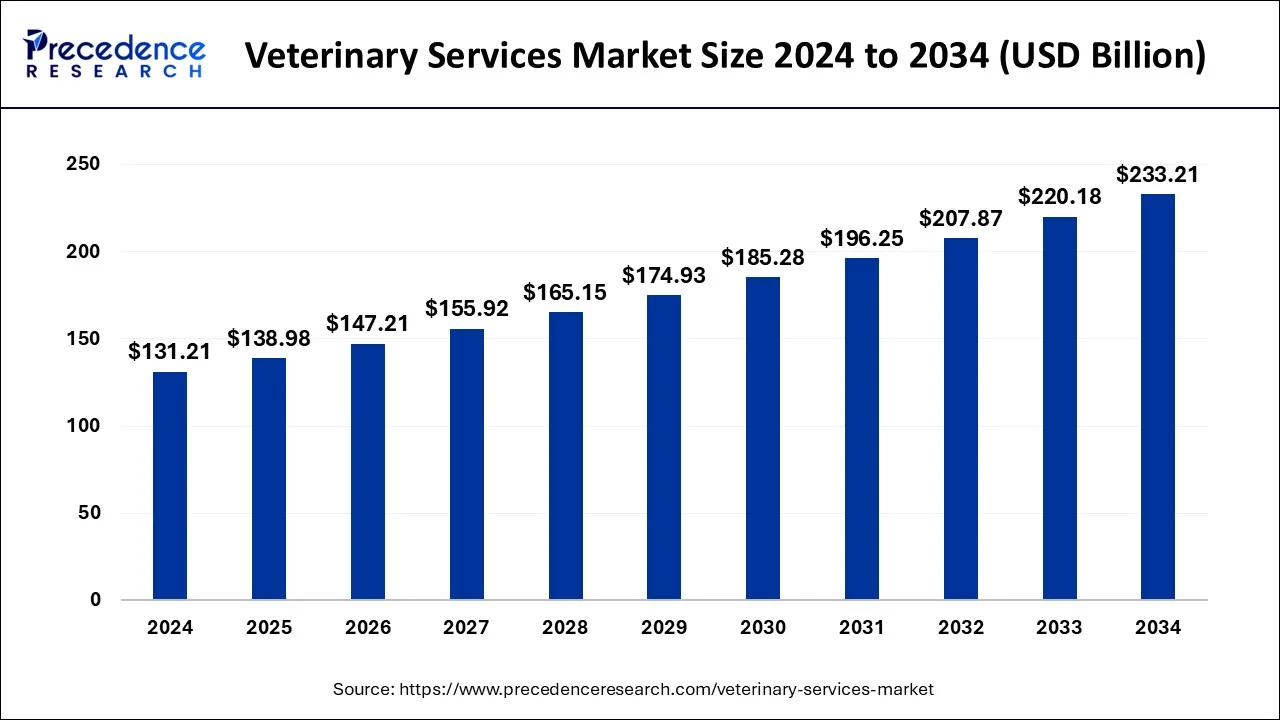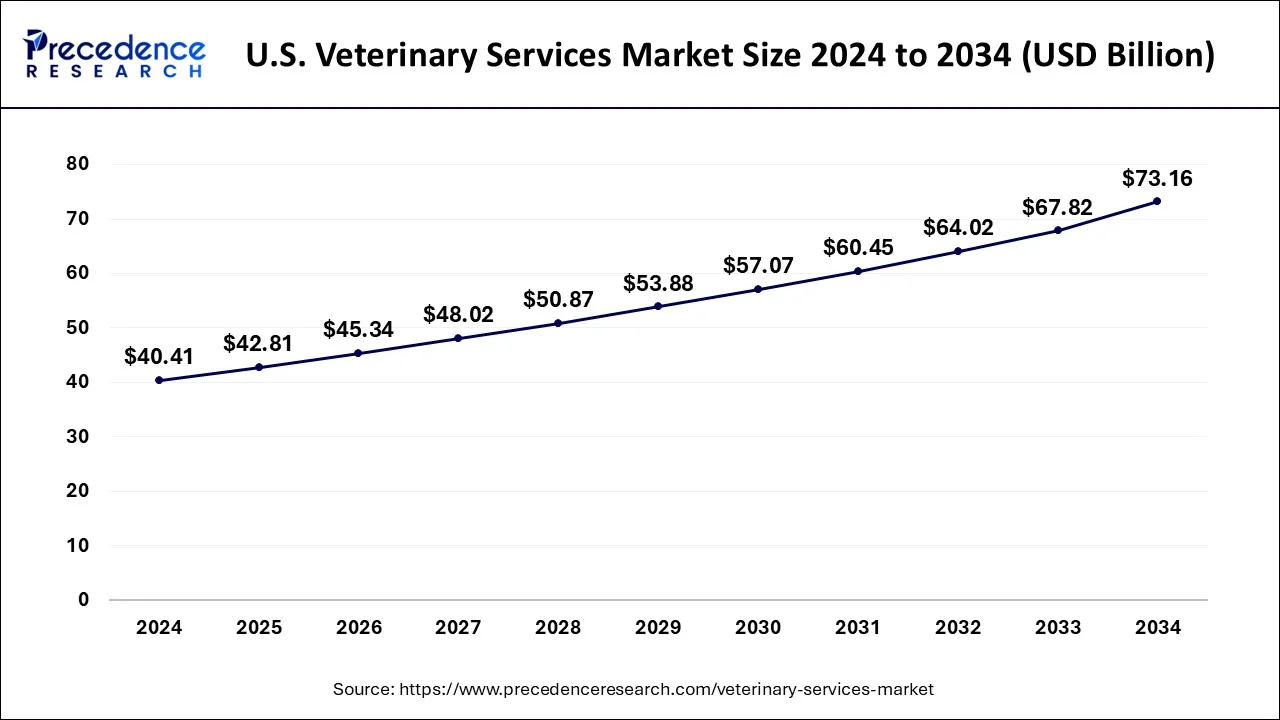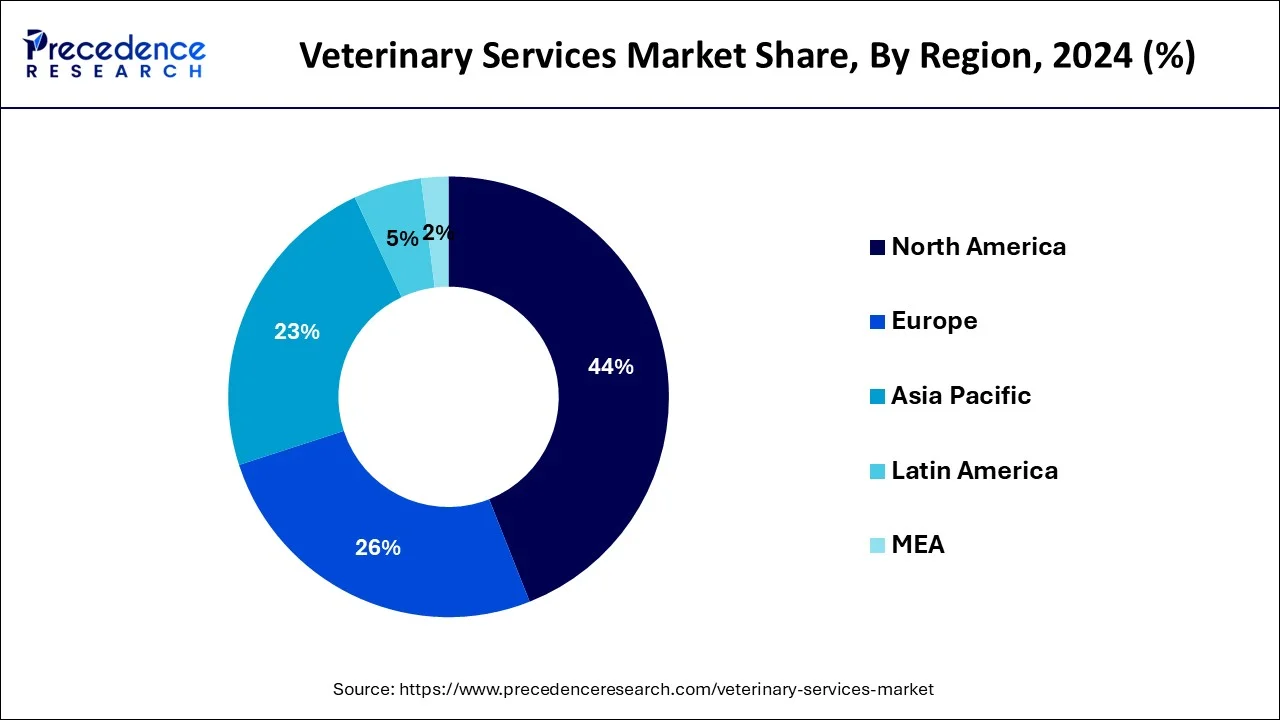What is the Veterinary Services Market Size?
The global veterinary services market size is calculated at USD 138.98 billion in 2025 and is anticipated to reach around USD 233.21 billion by 2034, expanding at a CAGR of 5.92% between 2025 and 2034. The market is expected to grow due to increased pet ownership globally, increased awareness of animal health and health-related issues, increasing amounts of research and development, increased uptake of pet insurance; increased expenditures on pet health care, and the emergence of innovative and advanced technologies like mobile veterinary units.

Market Highlights
- North America dominated the market with the largest share in 2024.
- By region, Asia-Pacific is expected to grow at the fastest rate during the forecast period.
- By service insight, the diagnostic tests and imaging services segment dominated the market in 2024.
- By animal type insight, the companion animals segment led the market in 2024.
Market Size and Forecast
- Market Size in 2025: USD 138.98 Billion
- Market Size in 2026: USD 147.21 Billion
- Forecasted Market Size by 2034: USD 233.21 Billion
- CAGR (2025-2034): 5.92%
- Largest Market in 2024: North America
- Fastest Growing Market: Asia Pacific
AI in the Veterinary Services Market
The future of veterinary services is taking new turns with the introduction of Artificial Intelligence (AI). It is improving diagnosis and treatment processes as well as improving general operational efficiency in the veterinary services market. AI makes the most intricate analysis of medical records, laboratory tests, and imaging studies and assists veterinarians in the highly accurate detection of diseases and conditions. This would create better treatment strategies and allow for more effective interventions while decreasing the guesswork. Also, it allows one to reach telemedicine and remote care. Today, it allows real-time monitoring and consultation through telemedicine and remote care. AI-driven chatbots mainly take care of appointment scheduling while fielding queries and optimizing inventories while automating billing. In such ways, AI is speeding up veterinary research. Collaborations between veterinary professionals, AI specialists, and tech developers are very important in making this full realization possible. The future of AI in veterinary services is currently very bright with lots of room for further development and innovations.
Veterinary Services Market Growth Factors
The huge global increase in zoonotic and food-borne illnesses is the primary factor driving the market. The protection of animal health and welfare as well as the upkeep of the hygienic safety of international trade are vital functions of veterinary services. Additionally, it helps protect the general public's health and guarantees food safety. The Organization for Animal Healthcare (OIE) said in an article that there is a rising worldwide demand for foods derived from animals, including meat, which is anticipated to reach 445 million tons by 2050. Customers' preferences for shopping have changed from traditional brick-and-mortar stores to online marketplaces as a result of the COVID-19 pandemic, which has accelerated industry growth.
It is expected that a growing number of government measures to guarantee food security and biosecurity would hasten the adoption of veterinary services in cattle across the world. For instance, the OIE, which is concerned with preserving food safety, has continuously issued guidelines to remove possible biological dangers and risks connected with inspections on-farm, before slaughter, prior to processing, and during processing. Because more workers are working from home due to the pandemic, pet adoption has skyrocketed. Pets are a big part of many people's life. Many people view their pet as a member of the family. There are always cats and dogs around, and people are spending more money on them. In order to meet the growing demand, veterinary businesses produced new goods, diagnostic equipment, and services. This is a brand-new platform for diagnosing intestinal parasites in canines. Additionally, the following rise in pet ownership around the globe has aided in the market's quick expansion. In order to ensure animal welfare, veterinarians and veterinary service providers consistently make efforts, which motivates pet owners to employ these services.
- The growing prevalence of zoonotic diseases is increasing the growth of the veterinary service market
- Rapidly increasing pet adoption will result in an increase in the demand for pet care services
- Raising awareness about animal health is also fueling market growth.
- The growing number of cattle and poultry farm
Market Scope
| Report Coverage | Details |
| Market Size in 2025 | USD 138.98 Billion |
| Market Size in 2026 | USD 147.21 Billion |
| Market Size by 2034 | USD 233.21 Billion |
| Growth Rate from 2025 to 2034 | CAGR of 5.92% |
| Base Year | 2024 |
| Forecast Period | 2025 to 2034 |
| Segments Covered | Service Type, Animal Type, and Region |
| Regions Covered | North America, Europe, Asia-Pacific, Latin America, and Middle East & Africa |
Market Dynamics
Key Market Drivers
The willingness of pet parents to spend more on pets
- About 70% of American families would have at least one pet in 2021, according to the American Pet Products Association (APPA). Over the past few decades, pet care spending in the United States has climbed both nationally and per person. The North American Pet Health Insurance Association (NAPHIA) estimates that in 2020, the total written premiums for pet insurance in the United States will exceed $1.99 billion. With the help of pet insurance, pet owners may effectively spend money on high-quality services for their animals and provide them with the best possible care, lowering their out-of-pocket costs. Additionally, it has been noted that the adoption rate of pets has grown recently. In 2021, 14% of new and current pet owners adopted a new animal, according to the APPA. As a result, the market as a whole is anticipated to expand considerably over the course of the forecast period due to increased pet adoption and pet insurance programs.
Key Market Challenges
Rising costs of veterinary services may hamper the market growth
- Increasing demand for veterinarian services, an increase in the number of pets, and technical developments in clinical procedures all contribute to rising veterinary service prices. This is anticipated to limit market expansion somewhat. For instance, according to the American Veterinary Medical Association, over 38% of dogs and over 40% of cats made up the pet population in the United States in 2020. Furthermore, just 5% of cats and 10% of dogs have pet insurance, according to a poll by the American Pet Product Association. Even though it is growing, the pet insurance market in the United States is still very young. Additionally, the cost of veterinarian services has climbed 2015 by over 10% for clinical treatments and more than 5% for routine check-ups, according to the Nationwide/Purdue University Veterinary Price Index. Prices for both veterinary surgical procedures and pharmaceuticals are showing a similar rise. As pet insurance products become more widely used, it is projected that the aforementioned aspect will have a minor long-term influence on the industry.
Key Market Opportunities
Increase in pet adoption
- Because so many people were working from home during the coronavirus epidemic, the adoption of pets increased. Many people view their pet as a member of the family. To meet the demand, veterinarian businesses introduced several new goods, services, and diagnostic equipment. The development of the veterinary services sector is anticipated to be aided by rising consumer spending on veterinary care, a rise in pet ownership, and a rise in the number of poultry and cattle farms. Throughout the anticipated period, rising pet adoption in Southeast Asia and Central America will additionally fuel the market for veterinary services. In the case of an incident or infection, pet owners are more worried about the health of their animals and take better care of their livestock. As a result, the market value for veterinary services will rise significantly in the near future.
Government programs for animal care
- Government institutions work with veterinary associations to establish programs that guarantee the best inventory availability in sectors for treating domestic animals. The rising need for veterinary supplies is a reflection of veterinary services industry developments. Additionally, it is anticipated that throughout the forecast period, rising per capita spending on animal healthcare and an increase in animal health consciousness would fuel the market development.
Segments Insights
Service Type Insights
The market for diagnostic tests and imaging services generated over USD 34 billion in revenue in 2024, and it is expected to continue to dominate over the forecast period with a sizable market growth rate. Pets who get infectious illnesses run the risk of dying, and farm animals are frequently less productive as a result. The potential of disease invasion is exacerbated by the globalization of the animal and allied product trade. The detection, control, and eradication of such illnesses depend on accurate and timely diagnostic procedures. As a result, veterinary services including diagnostic testing and imaging have increased. The development of equipment and auxiliary instruments for the quick and simple identification of animal diseases has been prompted by the requirement for imaging and diagnostic tests. The creation of prototype diagnostic tests for a variety of zoonotic illnesses is made possible by revolutionary technological technologies for personalized human medicine. A veterinary clinic also uses cutting-edge imaging technologies in its radiology and imaging rooms to identify and treat illnesses in animals. Therefore, as a result of the aforementioned factors, the market for veterinary services is anticipated to continue to grow over the projected period.
Animal Type Insights
Over 60% of the market was predicted to be occupied by companion animals in 2024. The need for pet care services, including veterinary services among others, is significantly increased by the growing adoption rate of companion animals. For instance, The American Pet Products Association (APPA) estimates that in 2021, pet owners would spend USD 1,480 on average per year on the essential costs of a pet dog. Similar to this, there has been a marked rise in the prevalence of several illnesses in animals kept as pets. In 2018, it was projected that 2.5% of dogs in the UK have osteoarthritis, according to research that was published in the Nature Journal. Additionally, about 8% of cats and 10% of dogs received surgery, according to the APPA's 2017-2018 National Pet Owners Survey data. As a result, the market need for veterinary services will increase as more pets undergo surgical operations.
Regional Insights
U.S. Veterinary Services Market Size and Growth 2025 To 2034
The U.S. veterinary services market size is anticipated to surpass USD 42.81 billion in 2025 and is expected to be worth around USD 73.16 billion by 2034, poised to grow at a CAGR of 6.12% from 2025 to 2034.

North America had the biggest revenue share of more than 43% in 2024.The main causes of this significant expansion are the determined actions conducted by various government animal welfare groups geared at the enhancement of veterinary services in the United States and Canada. It is projected that the proliferation of new animal education programs in the United States, including unconventional programs seeking accreditation, will increase access to these services and hence increase the potential for acceptance of veterinary services in the years to come.

On the other hand, during the anticipated years, Asia Pacific is expected to see the quickest rate of growth. The regions developed and developing economies' expanding pet and livestock populations are the cause of the exponential rise. Additionally, because they aid in the maintenance of the priceless livestock herd, veterinary services also serve to lower poverty, particularly among rural communities in developing nations. The number of veterinarians in Japan who treat pets and other small animals is rising, which might present a development opportunity for the industry. The increased demand for goods like meat and milk as a result of the expanding population, which leads to animal husbandry, is predicted to enhance the need for veterinarians and their services in India.
Veterinary Services Market Companies
- Merck Animal Health
- Ceva Sante Animale
- Vetoquinol S.A.
- Zoetis
- Boehringer Ingelheim GmbH
- Elanco
- Nutreco N.V.
- Virbac
- Kindred Biosciences, Inc.
- Biogenesis Bago
- Indian Immunologicals Ltd.
- Neogen Corp.
- Hester Biosciences
- Phibro Animal Health
- Dechra Pharmaceuticals PL
Latest announcements
- Brian Garish, president of Mars Veterinary Health International, applauded the mission of Crown Vet to improve pet health in India. Garish emphasized the alignment of Mars' Purpose with Crown Vet's mission, aiming to enhance pet care and training for local veterinary professionals.
Recent Developments
- In July 2024: Pawan Kotwal an advisor to Lieutenant Governor LG, UT Ladakh, launched Mobile Veterinary Clinic Services for the rural areas and animal husbandry, which has been funded by Livestock Health and Disease Control Programme of the MoF, DAHD, Government of India, for inaccessible and remote areas of UT Ladakh.
- In March 2024, A'alda Group, the preeminent provider of quality veterinary services, launched its first Japanese pet care facility in Gurugram, India, making the achievement even more worth its global expansion strategy. It is a significant step in the international expansion plans of A'alda and its commitment for the provision of great pet healthcare worldwide. The facility forms part of the expansion plans in Delhi and Noida.
Segment Covered in the Report
By Service Type
- Diagnostic tests and imaging
- Physical health monitoring
- Surgery
- Others
By Animal Type
- Production
- Poultry
- Swine
- Cattle
- Sheep & Goats
- Fish
- Companion
- Dogs
- Cats
- Horses
- Others
By Region
- North America
- Europe
- Asia-Pacific
- Latin America
- Middle East & Africa (MEA)
For inquiries regarding discounts, bulk purchases, or customization requests, please contact us at sales@precedenceresearch.com
Frequently Asked Questions
Ask For Sample
No cookie-cutter, only authentic analysis – take the 1st step to become a Precedence Research client
 sales@precedenceresearch.com
sales@precedenceresearch.com
 +1 804-441-9344
+1 804-441-9344